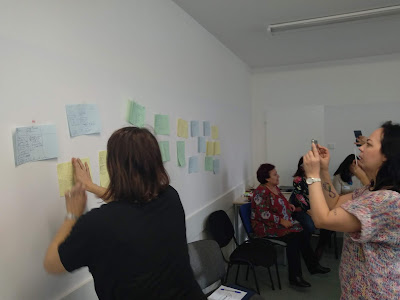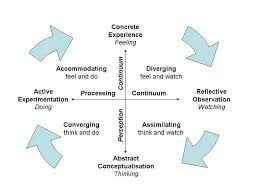Approaching Multicultural Issues and Mixed Ability Classes
First day has been very interesting!
Inclusion and integration
After a bit if theory from the trainer, each teacher has explained the situation in their school, the problems they face everyday and how the school management or government deals with them.
All agree that the theory in good but to make it successful, more support teachers and assistants are needed in the classrooms. This is a general feeling among all the teachers around Europe.
And in the evening, a walk in the town center and the Christmas market.
NEXT DAY...
Everybody can be useful for the group if they are given a task that uses his/her "strengh".
A long day sitting in class. Luckily the trainers give a coffee break every hour and a half. And every half an hour, magistral lesson is interrupted to do some collaborative work in small groups.
We have revised Gardners multiple intelligences at learning
Belbim team's roles
Bloom's taxonomy explaining how to develop the abilities or Remembering, Understanding, Applying, Analysing, Assessing and Creating (which have been cut in half in post studies).
All of these are studies to see how people learn. A conclusion we came to is that we have to use different approaches so that each student has a chance to learn in the way that better suits him/her and most enjoy.
All of these are studies to see how people learn. A conclusion we came to is that we have to use different approaches so that each student has a chance to learn in the way that better suits him/her and most enjoy.
When it comes to collaborative work, we can organize the students attending to different grouping depending on the activity. Everybody can be useful for the group if they are given a task that uses his/her "strengh".
LESS THEORY, MORE PRACTISE
Strategies for MAC (Mixed Ability Class)
1. FLEXIBLE CLASSROOM LAYOUT
2. OPEN ENDED activities:
Ciquain - Diamond (poem 1-2-3-4 words )
4 corners
Alphabet-mind map (example: EU, Words on alphabet, explain, mind map..)
Ciquain - Diamond (poem 1-2-3-4 words )
4 corners
Alphabet-mind map (example: EU, Words on alphabet, explain, mind map..)
3.LANGUAGE SCAFFOLDING
Speaking-writing frames
Sentence frame
10 top phrases on the wall
Graphic organizar
I.N.S.E.R.T. method
Yes/no chart
Visual instructions
4.GROUPING. How do we create efficient groups for projects?
Sentence frame
10 top phrases on the wall
Graphic organizar
I.N.S.E.R.T. method
Yes/no chart
Visual instructions
4.GROUPING. How do we create efficient groups for projects?
By self assessing their competences? Anonimously? Doing a team building activity?
Example: mark 5 things out of this list of skills and abilities: I am goods at: leading a group, planning, organizing, exploring, writing, presenting, listening. I am: ambitious, reliabole, responsable, independent, positive, creative…
The captains choose people for his group
5. COLLABORATIVE ACTIVITIES
6.VARIETY
7.INTEREST CENTERED
8.FREE HOURS TO WORK ON TASKS CHOSEN BY STUDENTS
9. COMPULSORY PLUS OPTIONAL TASKS
10.TASKS TO DEVELOP LEARNING TO LEARN STRATEGIES
11.INDIVIDUALIZATION OF GOALS
12.INTERCULTURAL EDUCATION
Creating space for their longue and identity, food festival , welcome in day of languages, flexibility, look for common points awareness:
-Onomatopeias / Caperucita in unknown language, to respect that the same reality can be seen differently in other cultures
-Ladybird and Riverbanks, to see all human beings have things in common
-Labels (against prejudices, to learn how people may feel in a different country)
-Double diary Clothes, video recycling Indian clothes, to see how people are unaware of others’ reality to see the need to be connected globaly
After lunch we centered on webpages where we can make our own materials to suit our students. We study pros and cons of using technology with teenagers. Here are some websites. You may know some of them!
LearningApps.com
Storyjumper
Edpuzzle.com
Kahoot
Quizizz
Joinmyquiz.com
Plickers
Developing writing, reading and speaking skills.
RWCT Reading and Writing Critical Thinking
RWCT Reading and Writing Critical Thinking
Evocation (key words, brainstorm, open task..)
Realization of meaning (given input, double diary, insert, jigsaw....)-
Reflexion
Free writing: in 3 minutes write anything that comes to your mind,even just words, don’t lift the pen, don’t worry about mistakes, don’t revise
Sentence started
Dixit cards game: what happened BEFORE this, What happened AFTER, how do you FEEL, What of your real life does it REMIND you of, if it were the illustration for a book give a TITLE, say three ADJECTIVES…)
ON THURSDAY...
We worked on multicultural vs intercultural education. After giving opinios and seeing to some documents, we tried different activities to work interculturality.
In the afternoon, we visited a "different" school, which works on projects: Smichovska Stredni Prumyslova Skola.
FRIDAT, LAST DAY!
Assessment in MAC
Why assessment? Who for?
Feedback for students about the quality of their work?
Feedback for the student’s parents?
Motivation for further work?
Feedback to improve the teacher’s teaching?
Tool for the governments to compare schools? Or teachers?
Ways to assess for CLIL
1.rubrics
2.checklist
3.self assessment
What is Formative and Summative assessment?
When the cook tries the soup, that is FORMATIVE assessment (it needs salt…). When the customer tries the soup, that is SUMMATIVE assessment (it is the best soup, it is horrible…)
We reviewed how students are assessed in primary and secondary schools around Europe. In most countries, students are assessed from 1 to 10.15 or 20. Only Finland seems to be in a changing period towards reports, more formative assessment.
















No hay comentarios:
Publicar un comentario
Comment here